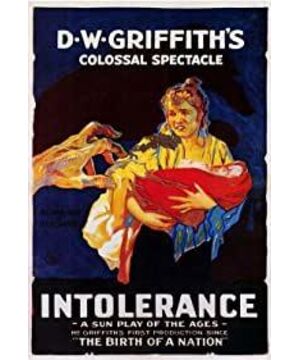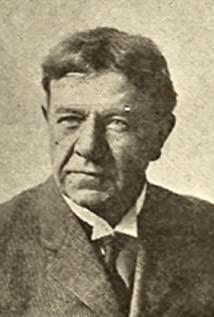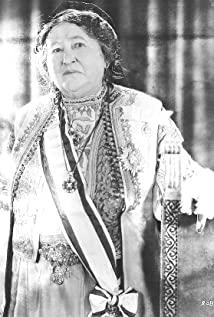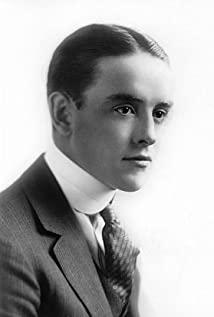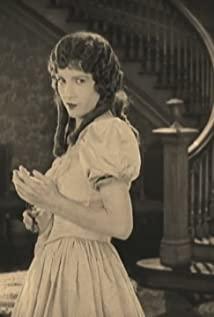"Cinema Begins with Griffith" - Jean-Louis Gouda, French New Wave
father of modern cinema
Griffith, as the "father of modern cinema," has, to a certain extent, little film technique to draw upon, but it is also inappropriate to attribute the establishment of the classical narrative, as stated in the press below, entirely to Grief. Feith, after all, there were also filmmakers in the same period, and in various attempts, they extended different techniques. In 1915, the classical narrative of "The Birth of a Nation" was quietly taking shape. Although the production method and the theme of blacks and the Ku Klux Klan ran counter to today's racial issues, it was "politically correct" at the time. Not only won an extraordinary social reputation, but also harvested a huge box office.
In 1916, "Unbearable" can be said to be the first collection of classical narratives, four parallel narrative lines, covering a variety of genres, themes and viewpoints at an epic level; from macroscopic ancient civilization wars, religious massacres, biblical stories, to microscopic urban popular of contemporary little people. , which revealed Griffith's deep and broad film control, and also laid the foundation for war, history, song and dance, crime, chase, love, popular and other types of films; however, his epic ambitions can be Not only the thematic narrative, but in terms of picture construction, Griffith used 15,000 ensembles and 250 chariots, as well as moving towers, fire-breathing chariots, elephant attacks, rotating gear gates, Babylonian palaces, etc., and the modeling and art design spanning multiple time and space have reached the peak level, so magnificent that it is doubtful whether this can still be photographed today? The vastness of wars and banquets, the dispatching range of ten thousand people is more than three floors, the quality of the extras is extremely high, and there are so many motivations and action designs that the overall sense of immersion is amazing and unbelievable; it even gives people a sense that it comes from a hundred years. Afterwards, rather than the déjà vu of a hundred years ago.
"The basis of film art is editing." - Pudovkin, Soviet-Russian montage
Editing—The Heart of Classical Narratives
The core of the establishment of classical narration is the narrative method of editing. Almost all classical lens language revolves around the rise of editing narrative. Editing progresses from a passive functional connection to a narrative technique that actively interprets ideas and emotions, enabling the author's ideas to be visualized and received by the audience, presenting the essence of Ashchuk's The Camera and Pen. The principle of editing is based on the diversity and difference of image materials, and the meaning of using mirrors for different scenes is enhanced. The meaning of the sequence expressed by the collision makes the composition step into the thinking of mirroring. On the basis of the medium shot, the arrangement of close-up, close-up and long-range views is introduced to create the enhancement, contrast and transformation of emotions and ideas, and more to lay out and stack. , pushes up emotion and conflict, and immerses the temporality of the film from the objective absolute (length) to the subjective relative, and the rhythm is born.
For example: in the middle shot, the main scene flows with the plot, and the close-up of the character's reaction is inserted, which strengthens and expresses the character's emotions, thoughts and attitudes, so that the actors can finally take off the stage and mime performances. It also technically avoids and reinforces the insufficiency of the actors, and even inserts a special expression that is deliberately disconnected from the main scene to present the character's extremely tense mood and emotions; and the development of classical editing today, more and more Relying on the techniques that are obviously not linked to the play, but hides the flaws like magic, so that the actor can blink between the eyebrows and can greatly manipulate the attitude and personality of a character under the sculpting of the in and out points of the editing. The risk of drama, indulging the audience in a carefully crafted reality. In the films of this period, the close-up of the plot-related objects or actions was also more emphasis on display rather than continuous play. In addition, the role of long-view from the opening to establish the environment has been moved to the different scenes, which has also made long-view the mainstream camera language, especially common in narratives of environmental oppression or epic battles; when two soldiers are fighting in the middle shot, the camera cuts To the far-reaching panorama of the entire war, not only greatly strengthened the conflict, but also expressed the tragic nature of the war through images.
"The juxtaposition of two montage shots is not the sum of the numbers, but the product of the numbers." - Eisenstein, Soviet montage
Parallel Montage
Linear narrative clips, but only the prologue of the classical narrative. When the independent timelines are juxtaposed and intertwined, the linearity is extended to the plane, creating a parallel and intersecting montage that runs through the entire film history like a train entering a station; the "last-minute rescue" cast in it is even more To this day, it is a deadly weapon that cannot be replaced in all commercial films. As the founder of montage, Griffith's accomplishments are not only in historical value, but today, it is still an unsurpassed textbook classic. "Unbearable" combines four completely independent storylines that span time, space, class, and viewpoint. Through the juxtaposition, induction, contrast, and reinforcement of parallel montages and theme montages, the connection between fields is highly expressive, as well as visual and conceptual. It stimulates or misunderstands the audience, greatly improves the amount of information and excitement, and reduces the sense of boredom. For example: Wife at home and husband in prison looking at each other through editing, narrative dislocation of cradle babies & modern babies, reflections on Jesus' good deeds & contemporary good deeds, Jesus close to children & modern child snatch programs, contemporary court trials & Pilate Judgment of Jesus, etc.; although "Unbearable" still relies on a large number of word cards in the transition, it is only a sound movie dialogue and a silent form of expression, and will be supplemented in the later paragraphs for the word cards.
cross montage
The parallel montages seem to have pushed the film to great heights, but it has yet to reach its true highs. Griffith goes a step further at the climax of the ending, incorporating cross-montages, completing the extremely complex, superb, and so far rare three-line parallel last-minute rescue, and in the Babylonian banquet and sneak attack, religious slaughter and rescue, modern execution and train In addition to chasing, interspersed and juxtaposed the cradle and Jesus on the cross, pushing it up to the interweaving of four lines and one mirror. In the last 20 minutes, 255 shots were used, and the scenes and shots were constantly switched, which greatly tested the director's use of the film. The diversity of mirrors, the meticulousness of the mirrors, and the control of the rhythm not only make the narrative clear and compelling, but also push the emotional tension to the extreme; and the epic sense of the theme montage is combined with the microscopic modern story. Strong collisions and contrasts, "Unbearable" summarizes the theme of all mankind, from ancient times to the present, from the world to the individual, the interpretation is unparalleled in length, breadth and height, setting the ultimate ceiling of epic movies.
space montage
In addition to the juxtaposition of time, Griffith also skillfully used the superimposing special effects to complete the juxtaposition in space, such as Jesus on the cross & the crowd, battlefield & heaven. The executed picture also interlocks the parallel contrast of space and time, so that the theme of the picture itself and the time axis can be said to be echoed, and it also indicates that the next era of subverting the editing narrative is coming: the picture is the first. The mise-en-scène montage, in 1939, culminated in the poetic realism of Renoir's Rules of the Game.
In addition to montage, Griffith also explored more effects and possibilities of editing narrative, such as the special effects of the head falling, or the flashback of the massacre plot that subverted the one-way timing, etc., which have repeatedly proved the reactionary nature of the film. Sexuality: Realizing the impossible in movies and reappearing the impossible in reality.
source of montage
In his montage paper, Eisenstein summed up "Unbearable", frankly admitting that the foundation of the Soviet-Russian montage theory originated from Griffith's classical editing; however, compared with Pudovkin, Eisenstein was a montage representative of the radical liberals , and also criticized "Unbearable" for being overly obsessed with parallel montages, delusional use of the cradle as a prototype or a mysterious symbol, and juxtaposing narratives of four distinct historical stories, but this allegorical symbol did not effectively establish a meaning relationship or sublimation in the time and space of each story. The dimension of abstraction and summary makes it still stay in realism; while those parallel juxtaposed narrative ideas, relying on false humanitarianism as support, also conflict with each other, so that Ge-style montage only stays at the level of parallel comparison. However, film history has also proved to this day that Pudovkin, who was close to Griffith, was a branch of Soviet-Russian montage and became the mainstream of contemporary classical narratives.
"If I see something through a viewing window that I find familiar, I try to look at it from a different point of view." - Gary Winogran, American Street Photography
photography around clips
In order to expand the synergy created by the images themselves and their permutations, Griffiths developed various photographic techniques around editing. As early as 100 years ago, "Unbearable" used a floating panning lens similar to a rocker arm, and used slow movements such as dolly in, pan, etc., to present the epic scene magnificently; unfortunately, there is still a lack of lens movement and picture elements. The expressive scene scheduling design makes the huge group performance scene closer to the background of the epic stage. However, from Dolly in's large and defocused expression, it can be seen that Griffith is consciously exploring the relationship between scheduling and narrative, emotion, and poetry.
Most of the main scenes in "Unbearable" are biased towards stage thinking. In addition to the absence of the foreground, the actors also face the mirror from the front and side. The narration and freehand brushwork have not yet been established; but the axis, direction and viewpoint of the opposite dance have been Quite skillful, it seems Pudovkin's "Mother" is more like a road idiot whose magnetic pole is disturbed, rather than a technical experiment to explore the axis and direction. The whole film is mostly used for performance, and montage is also used for the processing of large structures. As Eisenstein said, the lack of abstraction and freehand collide and flow between mirrors. It can be seen that the first generation of drama films focused on the narrative of editing, and the images were born for editing intentionally or unintentionally, which greatly diluted the independent expressiveness and expressiveness of the picture itself.
Define a close-up mask
What differentiates classical narrative photography from the stage is that it is dedicated to focusing and manipulating the audience's sights and senses through lens selection and editing. In addition to emphasizing and contrasting the focus of the picture through scenes, Griffith uses the "mask method" extensively. More radically, the focus of the picture is divided and highlighted by black screen, which is different from the more common round and square masks today, Griffith's more different pictures, tailor-made mask shape and movement, vignetting , horizontal oblique, triangular, lower third, etc. Basically, you can cover as much as you want; it even replaces the narrative method of concealing and revealing elements of camera movement. When the girl in the mountains is killed, the mask expands from the close-up of the girl's face to the feet. The dove, from the pain of small people, sublimated to the dove of peace in the big era.
The mask is Griffith's definition of close-up. Even in the same scene and angle of the lens, the mask is directly connected as a conversion from medium to close-up; in fact, the size of the focal object does not change, but because Shields other visual information, making it relatively magnified in terms of visual psychology; just like the lens designs that are used in Hollywood today, such as acting in the mirror, chasing the foreground, etc., they all use the principle of shielding to guide the audience subconsciously. Focus on the object itself Stimulate greater attention and expectations, and truly magnify in the psychological senses. Today, free and radical close-up masks have been replaced by more techniques, such as blurring depth of field, composition of environmental elements, perspective, light carving, visual focus editing, sound sources, etc., and use light to focus and guide the vision. The above is particularly important, but the keynote of this film is mostly soft light and normal tone, and light and shadow designs such as hard light, glare, high contrast, and carved light are rarely seen.
Masks have escaped the definition of close-up today, and have turned to re-framing to express different media forms, time and space, atmosphere, mood, point of view or idea; for example: "Dear Mummy" at the end of the film uses scene frames with character actions, from The 1:1 push to 16:9 wide format conveys the expansion of the mood.
The pursuit of color in black and white films
Although "Unbearable" is far from mature in terms of scene scheduling design and lens use compared with editing, it still uses many lens and optical techniques that have continued to this day; , slow motion, fusion, shadow, fade in and out, lightning effects, etc. It is worth mentioning that although the film dyeing technique was not pioneered by Griffith, as a precedent for full-film dyeing, it can be seen that Griffith not only thought about the grayscale of black and white films, but also explored the narrative meaning of film color.
The whole film does not use black and white, but uses pink, brown, and blue as the background colors, and mixes the colors, showing a multi-color effect such as orange, yellow, and purple, trying to restore the environmental atmosphere such as rainy, sunset, indoor lights, etc., for the overexposure method Reappearing silhouettes; more expressing emotions such as love, depression, warmth, indifference, blood-stained, fraternity, etc. through color. The color separation of this film is based on shots, rather than scenes and paragraphs, so that various colors are intertwined in the editing, especially the use of color logic to jump between the environment and mood, and even the expression of multiple meanings, so that in many shots , it is also difficult to intuitively feel its color intentions, but compared with nearly four hours of black and white, the dyeing really makes "Unbearable" more powerful in narrative expression and visual sense, and eyes lit up. The dyeing method of film production was still used in the 1920s and 1930s in the United States.
The extreme pressure and proliferation of word cards
The character card of "Unbearable" is the most compelling I've ever seen; it not only tells the plot itself, it is as fascinating as a picture book and storyteller, with smooth transitions and echoes of the four stories, but also mixed with poems, expositions, and even small characters. Historical or background information, and leave Griffith's initials DG on the bottom. Word cards are more particular about the form. The word cards have different substrates as the story changes, and the design is very atmospheric. The typesetting, font, bottom line, and color of the words change endlessly with the narrative. But what is criticized is that the proportion of word cards used is unexpectedly high. Although the parallel montage combination structure is used in the narrative, many transitions and corresponding metaphors between stories still rely on word cards to promote, connect, and emphasize. In contrast, even some obvious things are repeatedly expressed in word cards; however, as a pioneer in the development of camera language, how to communicate with the audience at that time is different from what we are today.
"Film is written in sand: applaud today, forget tomorrow." - DW Griffith, father of modern and American cinema
The cradle of endless
"The cradle that keeps swinging, the union of time and space, the singer of joy and sorrow." - "Unbearable". The whole film uses the "cradle" as the key, with a metaphorical blue color, a wooden room, a woman in the background, the dawn falls, the dust is floating in it, the peaceful mother, and the cradle that swings endlessly, constructing a scene of indescribable ambiguity Sex, shuttles between ancient and modern China and foreign countries, big eras and small people, it seems that the history of human intolerance is constantly nurtured in swaddling; it also seems that the years are endless, human beings are continuous, and the mother's love is pushing the cradle, " Today, like yesterday, the human feelings in the world are endlessly changing. The cradle is shaking, bringing the same passions, the same sorrows and joys to mankind.” The father of free poetry, Walt Whitman; it seems that in Griffey After observing the ancient and modern human society, he commented on the arduous history of human beings' struggle for tolerance for thousands of years, and used four stories from different eras and different regions to fable its universality and seek the answer to tolerance. , and also at the beginning of the drama film, the theme of the epic genre was set: love and tolerance. Griffith seems to have seen everything in the world. After three historical lines that seem to end in tragedy at first glance, the husband in the modern story is rescued from the death row by his wife, embracing each other and crying, and the fighting people are still in the opening of heaven. The card wrote, "Perfect love brings eternal peace." With a great light, the prisoners in the prison ran to the fields of blooming flowers through the overlapping shadows. The forts were covered with branches. The light of the cross stands between the sky and the earth, the whole sky is jubilant, the cradle is full of flowers, still shaking, the mother's close-up view is thoughtful, as if tasting the sweetness of this yearning, or just escaping the bubble of a fate .
"The most important tolerance is the tolerance of the state and society towards individuals." - "Einstein on Life" Einstein, the father of modern physics
A history of intolerance
"Intolerance: Love's Struggle Through the Ages." "Intolerance: Love's Struggle Through the Ages.", also translated "The Story of Prejudice"; in contrast, the Chinese translation of "Party to Fight Different" is more finishing touch. The treasonous priests conspired with Persia to destroy Babylon, the French royal family wiped out the Huguenots, the Jews and the Roman government sent Jesus to the cross, and the modern court sent innocent people to the gallows; Intolerance fundamentally deprives individuals of the possibility to choose tolerance. In order to escape the fate of being intolerable, individuals have to integrate into the intolerance of the group, and the state and society must continue to eliminate those outside the circle to achieve Establishing that short-lived and insignificant sense of security, like the curse of all mankind, endlessly circulates and grows in intolerance, greed and fear. Could it be that the swaying cradle has nurtured the endless tragedies of mankind? Perhaps there is one more, wider than greed, more lingering than fear, more powerful than everything in the world.
The idea of this film seems to be simple and general, and it seems that there is no more philosophical and literary exploration and research, but only through the contrast of the layers of images and the presentation of grand forms, the simple conception is transformed by the historical and literary The exposure and reproduction of reality force the audience into deep reflection.
"Man is the measure of all things: the measure of the existence of those who are, and the measure of the non-existence of those who do not exist." - Protagoras, ancient Greek philosopher
Unconscious partisanship
From 1914 to 1918, it was World War I, and America’s participation in the war was high. The “tolerance” utopian anti-war ideology promoted by “Unbearable” was far from the social trend. Coupled with the alienation of artistic value and popular culture, this film took a year. Half, an investment of 2 million US dollars and a 220-minute film history masterpiece, while harvesting the film's value for a hundred years, it also made Griffiths suffer a lifetime debt for the box office fiasco. What is worth thinking about is that racial supremacy and tolerance and fraternity seem extremely contradictory today, but in those days, they naturally coexisted in every individual in mainstream society; Griffith could kill black people in movies, but also The intolerance of all human beings can be condemned in the movie, and people can't help themselves to reflect on whether we take it for granted, even unconsciously isolate some groups and some individuals, even when we are promoting love.
postscript
The 168-minute HD restoration version of this viewing, provided by the Cohen Film Collection, is digitally restored by Modern VideoFilm; I have to say, I have heard the ghostly repetition of the restored soundtrack of "The Last Smile" ("The Meanest Man") , I will really be bipolar enough to want to kill, but the soundtrack of "Unbearable" produced by Carl Davis, 168 minutes without any cold scenes, skillfully flows between different time and space and tension, it is simply magical, and even Griffith's rebirth may be unmatched.
Faced with a silent film of nearly three hours, it can’t help but feel intimidating. Unexpectedly, watching a silent film is really addicting. The quietness of the art itself, the pure gaze, and even the admiration for the origin of film art, is a modern film full of sound, light and dialogue. Unattainable; sometimes brought in to a certain extent, as if the characters can still be heard talking, as if the image itself has sound, not only that, but also the taste. Whether it is boring or not does not depend on the silent film itself, but depends on the amount of information, stimulation and transformation that flow between the work and the viewer; just as we can stare at a painting for five minutes, but we cannot watch the interweaving of countless pictures. movie of. "Unbearable" explores the nature of Bianying so grandly. Just writing notes makes me forget the time. It also makes me sigh about the importance of "knowing movies". Movies are language, and language is so big that I really need a dictionary to understand my ignorance. with aphasia. Then I watched the five-and-a-half-hour silent film "Napoleon". It was weird, why did I start to be afraid again.
"Well, I certainly don't think I can do any worse." - DW Griffith
View more about Intolerance reviews


